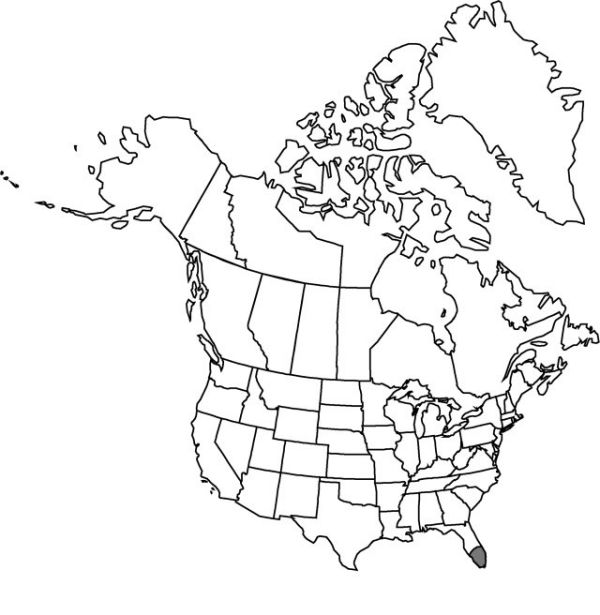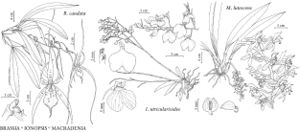Oncidium ensatum
Edwards’s Bot. Reg. 28: Misc. 17. 1842.
Plants mostly epiphytic, sometimes terrestrial, to 100 cm (excluding inflorescence). Stems modified into prominent, compressed pseudobulbs, subtended by 1–3 leafy bracts. Leaves 3, apical [2, lateral] on pseudobulb, 2 lateral; blade linearlanceolate, 60–100 × 3–5 cm, not leathery. Inflorescences erect-arching to pendent, 100–250 cm; bracts 5–8 mm. Flowers yellow with numerous small brown spots; sepals reflexed, oblongelliptic, clawed, 16 × 3.5–5.5 mm, margins somewhat undulate, apex acute; petals reflexed at least at apex, oblongelliptic, clawed,10–14 × 5–7 mm, apex acute; lip mostly yellow with brown patches near lip callus, 11–15 × 8.5–11 mm, apiculate, middle lobe about as wide as combined lateral lobes, isthmus 5–6 mm wide; callus of central ridge with 3–5 paired lateral ridges; column yellow, with pair of erect, axe-shaped, apical wings; pedicellate ovary [15–] 24 mm. Capsules pendent, ellipsoid, 18–20 × 8–20 mm.
Phenology: Flowering throughout year, especially summer–fall (May–Aug; Nov–Dec).
Habitat: In rich humus of dry hammocks and epiphytic on bases and knees of cypress trees in pockets of decaying debris
Elevation: 0[–1800] m
Distribution

Fla., Mexico, West Indies (Bahamas), West Indies (Cuba), Central America
Discussion
In describing Oncidium floridanum, O. Ames (1924) stated that the Florida plants were distinct from O. sphacelatum Lindley but failed to recognize the affinities of the Florida plants to the Mexican and Central American O. ensatum. Several differences between the plants from Florida and a cultivated specimen of O. ensatum from Guatemala were cited by R. P. Sauleda and R. M. Adams (1989). My study of Oncidium ensatum throughout its range reveals no features consistent enough to warrant recognizing the Florida populations as a separate taxon.
Selected References
None.
